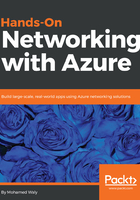
上QQ阅读APP看书,第一时间看更新
Azure portal (ARM model)
In 2014, Microsoft launched a new portal that follows a new model, called the ARM model, which can be accessed via the following link https://portal.azure.com/.
When you open the Azure portal, it will look as follows:

Figure 1.2: Azure portal
This model depends on the concept of resource groups, which means you can group all your resources within a container, resulting in resources being deployed in parallel. As a result, you will not face the same problems as you did with the ASM model.
The following diagram describes the deployed resources through the ARM model:

Figure 1.3: Resource manager management model at a high level
Here are the benefits you will gain using that portal:
- Ability to manage your resources as a group instead of managing them separately.
- Using Role-Based Access Control (RBAC) to control access to resources, so that you can assign permissions to a user on a resource or some resources, but not to other resources (as it was in the classic portal).
- Using tags to organize and classify your resources, which can help you with billing. For example, you might want to monitor the billing of some resources that make up a solution, for example, a web server. By assigning a tag to the resources that make up that solution, you would be able to monitor its billing, and so on.
- Support the usability of JSON to deploy resources instead of using the portal:
- Deploy resources in parallel instead of deploying them sequentially, and waiting until every resource deployment finishes to deploy another one.
- Specify dependencies during the resources deployment. For example, a VM will not be created until a storage account and a virtual network get deployed, because the VM VHD would need a place to be stored in and an IP address from a virtual network.
- Reuse of the JSON template to deploy solutions with the same specifications.